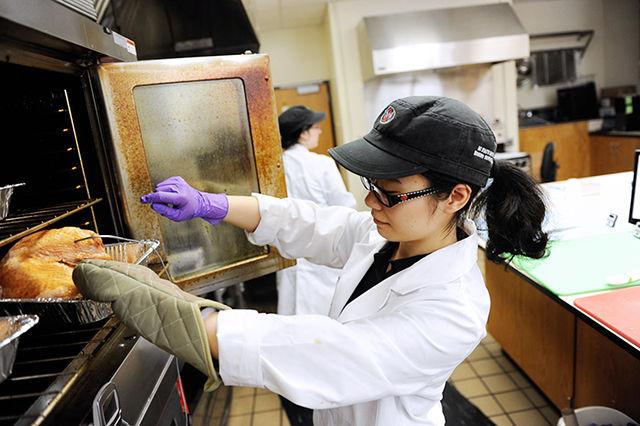Panelists step into their individual testing booths anticipating the food or drink they’re about to receive. It may be Mountain Dew, it could be pizza or sour cream. The testing time can be as short as 10 minutes or as long as 30 minutes.
All of this happens within the walls of the Sensory Service Center in Schaub Hall. Separate from research work, the Sensory Service Center was established in the early 1990s as a way to assist other faculty within the university with sensory testing. It has since expanded to assist the stakeholders in the College of Agriculture to do contract sensory work and to provide relevant training for students studying food science.
MaryAnne Drake, an associate professor of food science in the department of food science, teaches sensory analysis. She also supervises a large lab of graduate students whose research focuses on sensory analysis, dairy processing and flavor chemistry. As part of the service work and the students’ education, they work in the SSC, learning how to conduct sensory stats.
“When I say it’s a three ring circus, I’m really not kidding,” Drake said. “This is a fun job — it’s fun to do research, it’s fun to teach and see the direct application of what we do in the research and what we’re teaching.”
The SSC conducts various kinds of sensory tests on everything from dairy products to bread and meats. Before anyone is able to taste anything, though, they have to sign up to be in the database. The sign up tests them to see if they qualify and when they should take the test. The purpose of the screenings is to make sure the participants aren’t allergic to the product and to check that they regularly use the product
“We’re benefitting because the students that work for me are doing the work and it’s a valuable quality in the service of food science,” Drake said.
Typically, the SSC’s quotas reach around 100 people. Open tests are different; they are open to everyone until the SSC runs out of the product being tested.
Megan Parker, a graduate student studying food science and research assistant, said her role in the SSC is mostly planning and conducting consumer taste tests and participating on Descriptive Analysis panels. Descriptive analysis involves tasting food products to identify flavor or textural attributes and often times, takes a large amount of training.
“I’ve been on the path of becoming a sensory scientist from a young age,” Parker said. “In middle school, for a science project, I compared two different types of chocolate mousse recipes, low sugar vs. regular sugar. Since working at the SSC, I’ve gained experience working with many different clients and food products, which will both benefit me once I graduate.”
Kara McCarthy, a graduate student studying food science and research assistant, works as a panel leader and is in charge of making up the project questionnaires, recruiting panelists for the panels she is in charge of and analyzing the data when the panel is complete.
“For me, it is really neat to know the differences in the samples we are testing and then look at the results from the consumers and see which one they liked better and why,” McCarthy said.
Participation in these tests also has its own rewards. Besides being able to eat food, participants also get to walk away with a gift card or a food treat. A food treat, explained by Drake, is a can of pop or a candy bar that’s normally $1 at the vending machine. She explains that if the panelists receive a gift card, that comes from the food company or stakeholder that’s funding the test. When the SSC assists a class or helping out someone to run their research project, then they would use a food treat.
“If you’re participating in a test with a food you love to eat, you’re helping to make that food better,” Drake said. “At the end of the day, you’re having a voice in what’s going on with the food you eat and you also get a gift card or a food treat; what’s not to love about that?”








